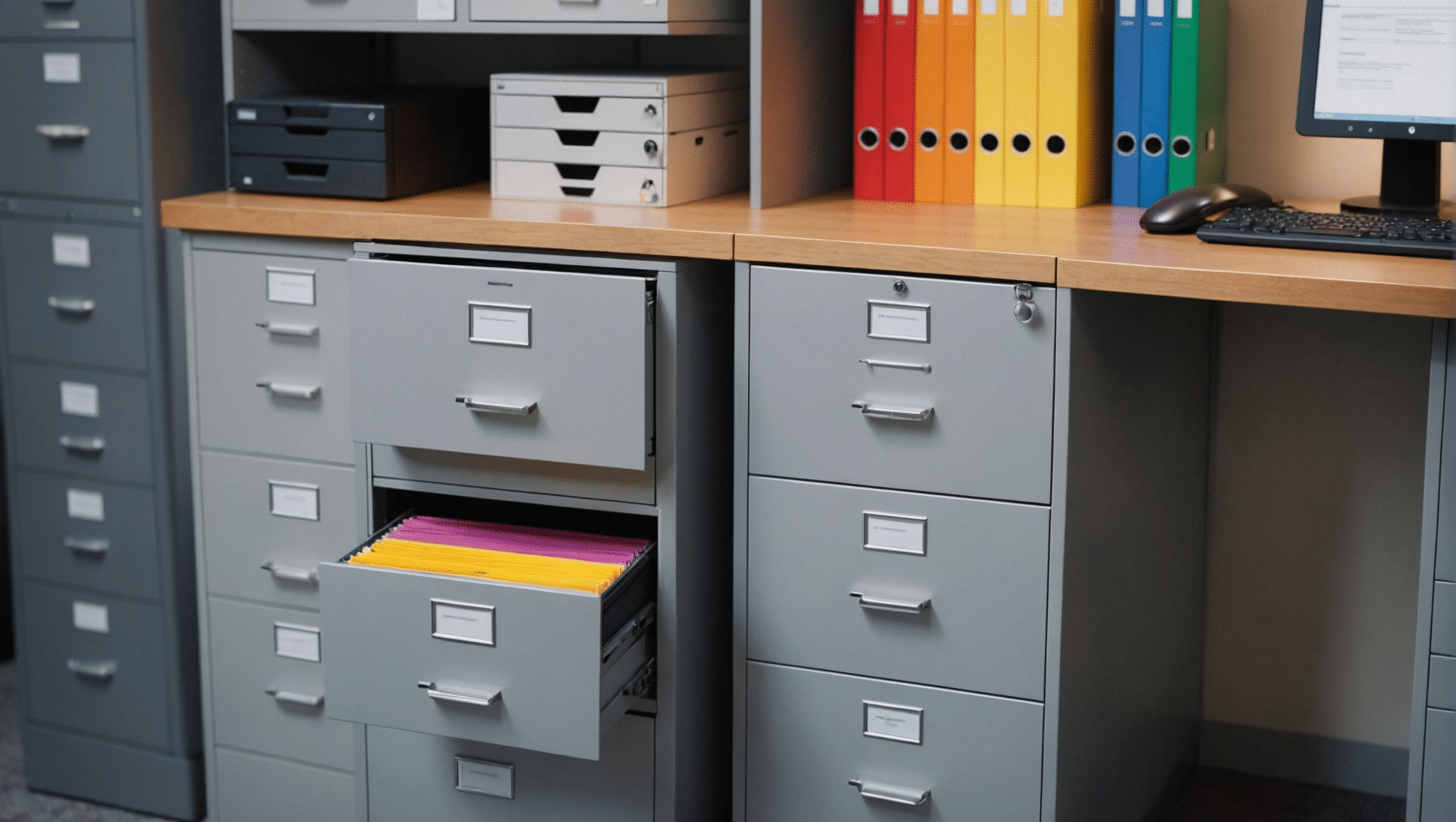
Unlock Maximum Filing Cabinet Capacity: How Many Documents Fit?
Maximize your OFFICE efficiency: Discover FILE CABINET capacities, from DRAWER dimensions to STORAGE limits and LOCKABLE features.
Last Updated on 06/10/2025
Knowing the capacity of a filing cabinet is crucial for efficient document storage and organization. This knowledge enables you to gauge how many documents and folders can be comfortably and safely stored, considering drawer count, weight limits, and overall volume, ensuring you make the most of your available office space.
How Much Material Can a Filing Cabinet Hold?
A filing cabinet’s capacity varies by model but typically includes measurements in terms of drawer quantity, maximum weight per drawer, and total volume in cubic feet or inches. Capacities range from small, personal units to large, commercial-grade cabinets designed to hold hundreds of files and documents.
Key Filing Cabinet Factors
- Assess drawer dimensions for optimal filing
- Consider maximum weight limit per drawer
- Check total volume capacity for document storage
- Account for future document accumulation
- Employ strategic organization techniques like dividers
- Factor in the need for secure lockable drawers
- Explore vertical filing for space efficiency

File Cabinet Capacity Explained
Let’s crack the code on file cabinet capacity, shall we? Picture this: you’re standing in front of a brand-new cabinet, its drawers are begging to be filled. But how do you know if it’s the right fit for your avalanche of documents? Well, it boils down to a few key factors—drawer count, volume, and yes, those pesky weight limits. Every drawer has its own story of space and constraint, a bit like the rooms in your house.
Now, you might think a drawer is just a drawer, but oh no, my friend. Imagine a drawer as a mini-office, where every inch and pound matter. That’s why understanding the capacity of file cabinets isn’t just smart; it’s essential. It’s not about how much you can cram in but how you can strategically place every file, making sure nothing is squashed or lost. The size (height, width, depth), tells a tale of what can nestle inside comfortably without turning your document retrieval into an excavation mission.
And remember, it’s not just about the here and now. Think ahead. Will your cabinet grow with your files, or will it buckle under the pressure? It’s a delicate balance, one that requires forethought and maybe a little math. The key is ensuring your cabinet’s capacity matches your office’s demands, making your storage solutions as efficient as your morning coffee run. And for those wanting a seamless fit, consider exploring diverse filing cabinet options here.
Measuring Document Storage Capacity
When diving into the ocean of documents cluttering your office, measuring storage capacity is your lifeboat. Think of it as the difference between a well-organized treasure chest and a pirate’s hoard strewn all over the place. The trick lies in not just counting folders but understanding the volume each piece occupies. It’s a game of Tetris, where every block (or document) must fit perfectly.
So, how does one embark on this quest of quantification? Start by assessing your pile of paperwork. Each file cabinet and drawer comes with its own personality—depth, width, and height. These are not just numbers; they’re the blueprint to maximizing your office’s efficiency. And let’s not forget the weight; a drawer sagging under too much pressure is a disaster waiting to happen. It’s about finding that sweet spot where everything fits snugly, allowing for easy access and retrieval.
Don’t shy away from leveraging tools and resources to get accurate measurements. It’s not rocket science, but it does require a keen eye for detail. Remember, a well-organized file cabinet is like a well-oiled machine, saving you time (and headaches) in the long run. And if your head is spinning with dimensions and figures, perhaps it’s time to check out more storage solutions to find the perfect fit for your paperwork paradise.
Optimizing Cabinet Storage
So, you’ve got your filing cabinet, and you’re ready to tackle the beast of disorganization. But where to start? First off, think of your cabinet not just as a place to dump papers but as prime real estate in the heart of your office. Every square inch is valuable, so filling those drawers cleverly will turn chaos into harmony. It’s like playing storage Jenga, where every move counts.
Employing dividers and folders isn’t just neat; it’s strategic. This way, you categorize, systematize, and simplify retrieval—turning hours of frantic searching into mere seconds. And here’s a pro tip: go vertical. Stack those files upright, and you’ll see just how much easier it is to browse through them. Plus, this method safeguards your documents from the dreaded bottom-of-the-drawer crease monster.
Here’s where lockable drawers earn their keep, securing sensitive documents from prying eyes and adding an extra layer of safety. And let’s talk color coding—because nothing says “optimized” like a rainbow of efficiency. By implementing these simple strategies, you transform your file cabinet from a paperwork black hole into an organized, accessible vault. For those seeking the ultimate optimization tools, contemplating a filing cabinet with state-of-the-art features might just be your next move.
Capacity Myths Debunked
Now, let’s bust some myths about filing cabinet capacity that have been floating around, shall we? First off, bigger doesn’t always mean better. You might think that the gargantuan cabinet that barely fits through your door is the answer to all your storage dreams. But in reality, it’s more about the fit and alignment with your needs—size, dimension, and capacity-wise—than just going for the biggest beast in the market.
Another myth? The “more drawers, the merrier” philosophy. While it might seem logical that more drawers equal more space, it’s the layout and utilization that truly count. A few well-organized, spacious drawers can trump a multitude of tiny, cramped spaces any day. And here’s a spicy take: not all files need to be stored in a cabinet. Yes, digitization is your friend; not every piece of paper needs a physical home. By scanning and storing documents electronically, you’re not just saving space; you’re stepping into the future of office organization.
Debunking these myths is more than just setting the record straight; it’s about optimizing your office storage in a way that truly benefits your work environment. So, before you fall for these cabinet capacity fairytales, take a step back and assess what your office really needs. Who knows, perhaps exploring a variety of office storage solutions will unveil the perfect match for your document dilemmas.
| Factor | Importance | Tip |
|---|---|---|
| Drawer Count | High | Opt for efficiency over quantity. |
| Volume Capacity | High | Assess document size and type. |
| Weight Limit | High | Avoid overloading to prevent sagging. |
| Size (HxWxD) | High | Ensure fit for office space and documents. |
| Lockable Drawers | Medium | Secure sensitive information. |
| Material Quality | Medium | Choose durable options for longevity. |
| Color Coding | Low | Implement for easy retrieval. |
| Digitization Potential | Medium | Consider for reducing physical storage needs. |
Conclusion
At Viking, our commitment to innovative workplace solutions extends to optimizing your filing needs. By focusing on maximizing filing cabinet capacity, we ensure your space remains both productive and cost-effective, aligning perfectly with environmental considerations.
Choosing Viking means embracing smart, efficient workplace practices that directly address your organizational challenges. Let us help guide your office towards enhanced functionality and productivity by transforming how you manage your filing systems.
Frequently Asked Questions
What is the average capacity of a standard filing cabinet drawer?
The capacity of a standard filing cabinet drawer typically ranges from 2,000 to 3,000 sheets of paper, depending on the files’ thickness and whether they are stored in hanging folders. The drawer’s dimensions, notably width and depth, play a significant role in determining its storage capacity.
How much weight can a lockable filing cabinet drawer hold?
A lockable filing cabinet drawer can generally support between 25 to 50 kilograms of weight, depending on its construction and materials. It’s essential to distribute the weight evenly across the drawer to prevent strain on the mechanism and ensure the cabinet remains stable and secure.
How does the number of drawers affect a filing cabinet’s overall capacity?
The overall capacity of a file cabinet is directly influenced by the number of drawers it has. More drawers increase the total volume of storage available, allowing for more files to be stored. Each drawer adds to the file cabinet’s storage capabilities, making larger cabinets with more drawers suitable for office environments that handle extensive paperwork.
Can the dimensions of a filing cabinet affect the types of files it can store?
Yes, the dimensions of a filing cabinet, including height, width, and depth, impact the types and sizes of files it can accommodate. Larger dimensions allow for bigger and more varied file sizes, including legal, letter, and A4. Additionally, specific configurations are designed to store items like blueprints or artwork, underscoring the importance of selecting a cabinet with dimensions that match your storage needs.









